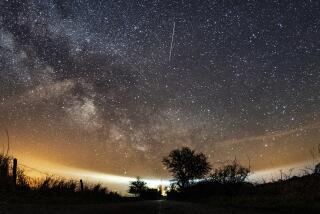Look up! Mars is closer to Earth than it’s been in 15 years
- Share via
Heads up, sky watchers: Tonight, Mars is going to be closer to Earth than it has been in 15 years, and you don’t want to miss it.
On average, Mars is about 140 million miles from Earth. But this evening, it will be just 35.8 million miles away, according to NASA.
To take advantage of this celestial alignment, just wait for the sun to set and turn your gaze to the east. You will see what looks like a red-orange star glowing unusually brightly in the night sky.
That’s Mars, and it’s the best view of the red planet that you’re going to get for the next 17 years.
Mars reached what astronomers call opposition on July 27. That means it was on the exact opposite side of Earth from the sun, with all three bodies forming a perfectly straight line.
“It’s basically the same geometry of a full moon,” said Bruce Betts, chief scientist for the Planetary Society in Pasadena. “It’s like we’re seeing full Mars.”
Even though Mars is now a few days out of its direct opposition moment, the fact that the planet will be closer to Earth than it was on Friday means it will be shining at least as brightly, Betts said.
As they travel around the sun, Mars and Earth pass each other about once every 26 months. But the distance between them during those passes changes in part because Mars has a significantly elliptical orbit. (Imagine a circle that’s been flattened a bit.)
“Right now, we’re approaching Mars when Mars is near the closest point to the sun on its orbit,” Betts said. “But next time we come close to Mars, it will be further from the sun, and further from us.”
The last time Mars was this close to Earth was in 2003. The next time won’t be until 2035.
“It’s a 15- to 17-year cycle because the periods of the orbits don’t match perfectly,” Betts said.
Usually, when Mars is this close, you can make out some of the dark and light regions of the planet even with a fairly small telescope. However, the planet happens to be in the midst of a global storm that has engulfed it in red dust, making those contrasts harder to see.
These planet-wide dust storms are not unheard of, Betts said. The tiny, bright red specks of dust are lifted into the atmosphere by the Martian winds, creating continent-sized dust storms that can occasionally morph into global events.
“It happens every couple of years, but this is the worst we’ve seen in a long time,” Betts said.
The dust was so thick that NASA’s Opportunity rover put itself into sleep mode in early July to conserve energy. It wasn’t receiving enough sunlight to charge its batteries.
If our own skies are too cloudy or smoky to get a clear look at Mars this evening, don’t despair. The planet will continue to appear especially bright throughout August.
And if you are already looking up at the heavens, make sure to scan the skies for a few other planets as well.
Saturn was in opposition on June 27 and is still shining brightly. It looks like a yellowish star rising in the southeast at nightfall.
You can also easily make out Jupiter, as well as Venus, which is the second-brightest object in the sky. (The moon is brightest.)
And the annual Perseid meteor shower is just around the corner. It occurs each year in August and is expected to be especially good this year, Betts said.
Its peak on Aug. 13 coincides with a nearly new moon, so the meteors will not be drowned out by the moonlight. You may want to start planning your getaway from the city lights now to make the most of it.
Happy skywatching!
Do you love science? I do! Follow me @DeborahNetburn and “like” Los Angeles Times Science & Health on Facebook.
MORE IN SCIENCE







